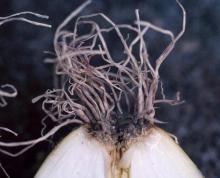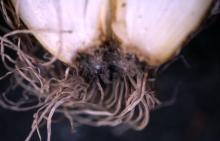By C. M. Ocamb and D. H. Gent
Cause Fusarium oxysporum f. sp. cepae is considered the primary causal agent, but other Fusarium species may infect the basal portion of onion plants. Fusarium oxysporum f. sp. cepae is a soilborne fungus that can affect onion and other Allium species including garlic. The fungus survives many years in the soil due to the production of durable spores known as chlamydospores. Fusarium species in general can potentially increase their population on plant debris as well as in the rhizosphere of asymptomatic plants. Infection often is associated with other factors that cause wounding of the belowground structures including Phoma terrestris (pink root disease), maggots, or other insect injury. Onion fields affected with this disease and pink root can lose half or more of the normal yield. Onion plants infected with F. oxysporum f. sp. cepae may remain asymptomatic in the field but disease can develop after harvest while in storage.
Symptoms Plants may become infected at any point during their time in the field. Yellowing and browning of leaves begins at the tip and moves down. Affected plants exhibit weak growth, may wilt, and potentially die off. Red-brown rot appears where roots are attached to the basal plate. Rot and discoloration usually affect the entire base and up into the bulb scales; affected tissue appears brown and watery when bulbs are cut open. Sometimes, a white moldy growth develops on the stem plate or between affected scales.
Cultural control
- Plant resistant varieties. In a Malheur County, OR test, these onion varieties had less basal rot: 'Golden Cascade', 'Cima', 'Oro Grande', 'Valient', and 'Cashe'. Other onion varieties described as tolerant but not tested in Oregon are 'Bronze Reserve', 'North Star', 'Sassy Brassy', and 'Sentinel'.
- Use 4-year or longer crop rotations.
- Protect plants from insect, fertilizer, or other injury.
- Clean equipment after working in infested fields; power washing to remove soil and plant debris will aid in reducing the spread on-farm.
- Storing bulbs at 39°F minimizes postharvest losses.
Chemical control Preplant soil fumigation effectively controls the disease on mineral soils but not on peat soils. Note: Fall fumigation is more effective than spring.
- Telone C-17 at 10.8 to 30 gal/A. Caution: Fumigation must be done before planting, so it is important that the planting row be directly over the fumigated soil if only the planting row is treated. Variations of a few inches can cause complete loss of control. Use highest rate on peat soils. Restricted-use pesticide. 5-day reentry.
- Telone II at 9 to 12 gal/A on mineral soils, 25 gal/A on peat soils. Caution: Fumigation must be before planting, so it is important that the planting row be directly over the fumigated soil if only the planting row is treated. Variations of a few inches can cause complete loss of control. Restricted-use pesticide. 5-day reentry.
Biological control Efficacy unknown in the Pacific Northwest.
- Bexfond at 7 to 28 fl oz/A for soil applications at planting via drenches, in-furrow applications, drip irrigation, or sprays, followed by irrigation, and reapply at 4-week intervals. 4-hr reentry. O
- Stargus at 6 to 8 fl oz per 1,000 ft row as an in-furrow treatment or 3 to 4 quarts/A as a soil drench (drip or chemigation) on 10- to 21-day intervals. Preharvest interval is 0 days. 4-hr reentry. O
Reference Degani, O., and Kalman, B. 2021. Assessment of commercial fungicides against onion (Allium cepa) basal rot disease caused by Fusarium oxysporum f. sp. cepae and Fusarium acutatum. J. Fungi, 7, 235. https://doi.org/10.3390/jof7030235.
Kalman, B., Abraham, D., Graph, S., Perl-Treves, R., Meller Harel, Y., and Degani, O. 2020. Isolation and identification of Fusarium spp., the causal agents of onion (Allium cepa) basal rot in Northeastern Israel. Biology 9(4):69. https://doi.org/10.3390/biology9040069.
Schwartz, H.F., and Mohan, S.K. 1995. Compendium of Onion and Garlic Diseases. St. Paul, MN: APS Press.


